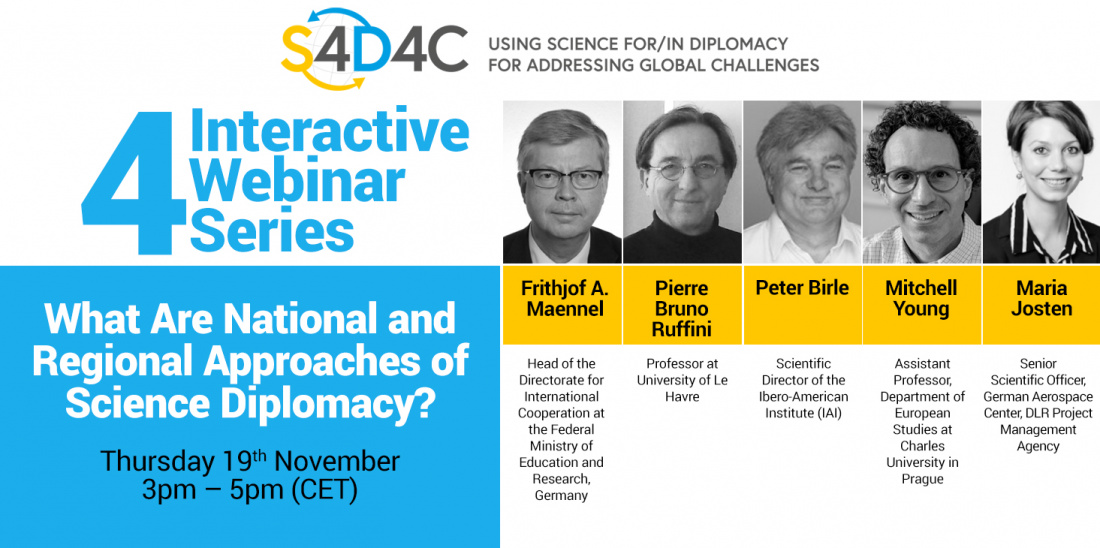One way to identify national (or regional) approaches to science diplomacy (SD) is to scrutinize documents from national and international diplomatic contexts in which diplomacy meets science and vice versa. You may find policy guidelines or even just short sections that point to a specific understanding of science diplomacy. One may suppose that such an understanding has a political underpinning, which was set in a country’s foreign policy deployment and which is now implemented by its diplomats. Module 5 of the S4D4C open Online Course has mainly focused on this approach, by interpreting science diplomacy strategies as representations of national – or regional – policymaking.
However, a specific approach to science diplomacy is not only expressed in the official announcements of public diplomacy. It is also reflected in the behaviour of diplomats and of scientists who interact with one another. We could therefore base our understanding of SD on a perspective that goes hand in hand with the attention we pay to the individual behaviour of statesmen and scientists. Cultural differences may lead to variant behaviour in negotiations. Several case studies show us a need to respect such differences in fields of international relations, foreign policy, and diplomacy.
The national or regional access to SD is thus marked by current political dynamics, interests and, sometimes, of course, by tensions. Against this background, it is important to look at current situations and to recognize the use of different strategic approaches of science diplomacy.
Due to these differences, we have chosen three European (Germany, France and Spain) and three non-European countries (China, Japan and USA) for our S4D4C Online Course: They share the criteria of leading in science, technology and innovation, but they have different cultural identities as well as political and scientific structures. Additionally, the way these countries pursue their own national interests impact the shape and characteristics of the joint initiatives that are undertaken in order to face global challenges.
While our 3rd S4D4C webinar (and Module 4 of the course) focused on the European perspective, in the 4th webinar we reflected also approaches outside Europe. The comparison with other regions and countries is crucial for establishing diverse views as well as an intensive discussion addressing global challenges.
Several guest speakers supported this approach to science diplomacy from multiple regional outlooks. The webinar was opened by Elke Dall, S4D4C project coordinator, who welcomed all the participants and introduced the key elements of the S4D4C project and the logic behind the interactive webinar series.
Maria Josten, Senior Scientific Officer, S4D4C partner, who was chairing the session, invited Lorenzo Melchor to start the ice-breaking session with the help of the Mentimeter tool.
Lorenzo asked the attendees to answers a few questions to get to know each other interests better. To the question “To what extent do you align with the following diplomacy goals?”, the audience values all goals to a relatively high extent, with a bit less interest for subnational level. Subnational levels are indeed less common/known in the science diplomacy world. For an example of subnational SD approach we recommend visiting our knowledge resources page on the subject.
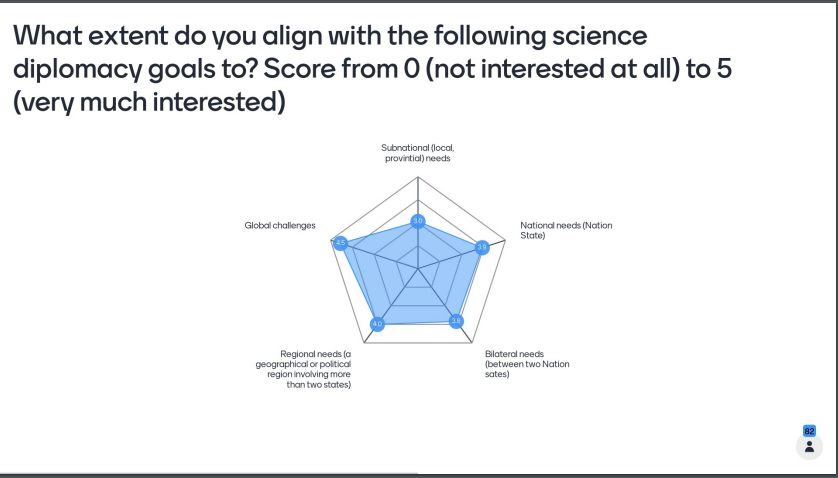
Lorenzo then asked the audience to reflect on the science diplomacy practices of their country of origin. The main national activities that our participants are aware of seem to be related to the participation in international organisations, bilateral and multilateral agreements as well as to national networks of science attachés and science counselors:
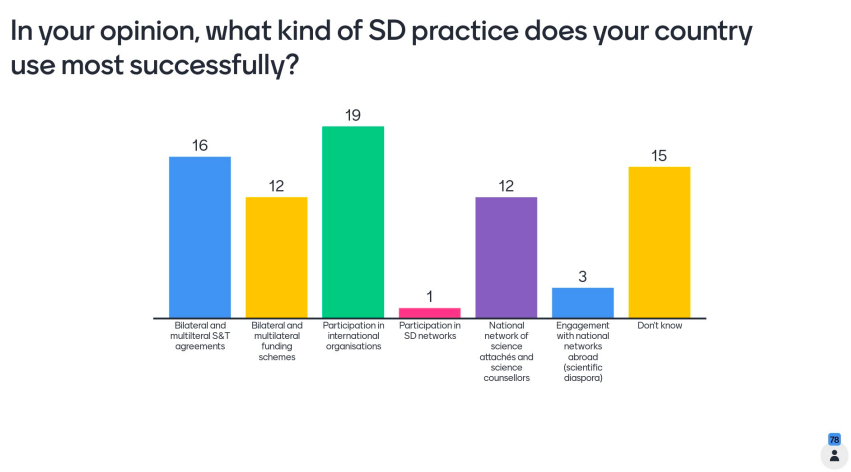
The ice-breaking session was followed by a roundtable featuring our guest speakers who shed some light on the variety of national and regional science diplomacy approaches.
The roundtable was opened by Mitchell Young, Assistant Professor, Department of European Studies at Charles University in Prague and S4D4C team member. Mitchell reflected on what makes science diplomacy and on S4D4C journey to find the key elements which define a science diplomacy practice and approach. Unsurprisingly, there is not just one single approach. In fact, several elements seem to matter for science diplomacy. This is illustrated by the recent publication The ‘Matters’ of Science Diplomacy: Transversal Analysis of the S4D4C Case Studies. It illustrates the multiple elements that could be seen in our case studies on science diplomacy.
It is constructed around 10 ‘matters’, one of them being geography, as it plays a role in shaping science diplomacy practices. Scale and levels have also been recognized as an important point where (1) global, (2) sub-global, (3) national, and (4) sub-national levels interact in the science diplomacy interface and therefore shape how it is understood and practiced. In the multi scalar context, diversity of interests has to be accommodated. There are no unified interests among actors of science diplomacy and they all interact with each other often in an implicit manner. All those elements matter for looking at regional approaches of science diplomacy.
The COVID-19 crisis is an additional challenge for science diplomacy but it is also an opportunity for collaboration between regions and fields. This is illustrated in our S4D4C infographic which was released on the day of the webinar.
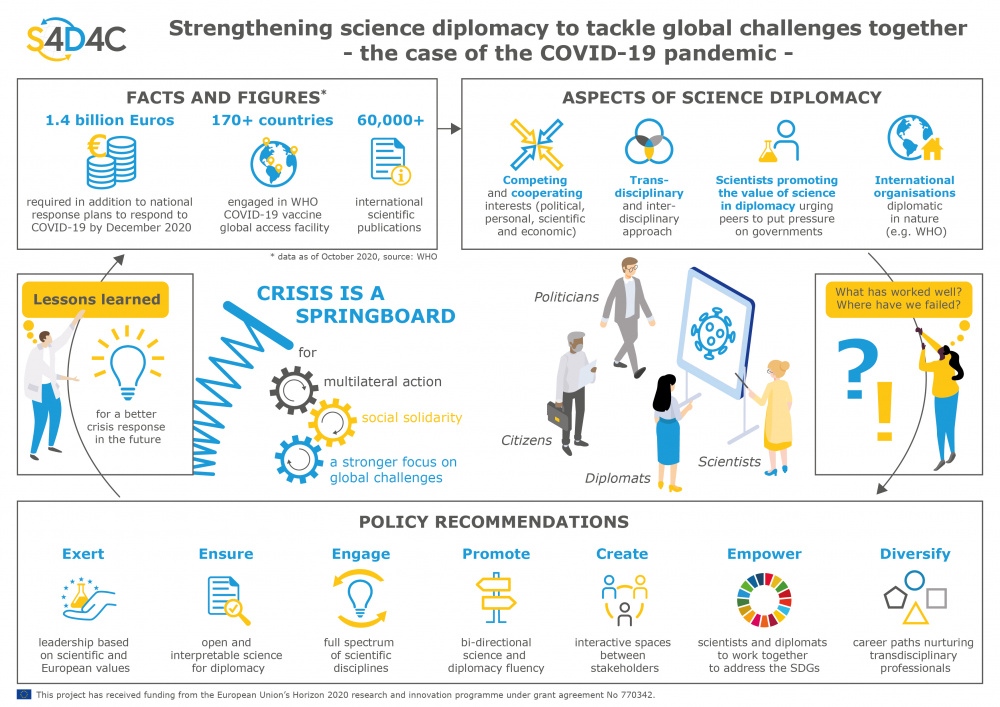
The panel session is important as it addresses the often overlooked regional aspect of science diplomacy. Mitchell then opened the roundtable discussion which featured the following experts:
- Frithjof A. Maennel, Head of the Directorate for International Cooperation at the Federal Ministry of Education and Research (BMBF), Germany
- Pierre Bruno Ruffini, Professor at University of Le Havre and member of the InsSciDE project, and
- Peter Birle, Scientific Director of the Ibero-American Institute, Berlin.
Maria launched the discussion by asking each of the panelist to elaborate on their motivation for engaging in science diplomacy.
Frithjof answered that for him, science is not possible without science diplomacy. A lot of scientists are now becoming aware of that, which explains their large participation in such events. However, we need more diplomats involved in science diplomacy discussions. He also stated that most scientist are actually already science diplomats. This comment created quite some discussions in the chat, where attendees questionned whether that was indeed the case and whether the world ‘diplomat’ could loose its meaning if applied too broadly.
Pierre-Bruno, expressed that as an academic, his career took a turn when he started working for an Embassy and learned about science diplomacy – he realised that his work had a name and later, when coming back to academia, he dedicated some of his research to science diplomacy.
Peter’s interest in science diplomacy grew from the development that he was witnessing in international relations, of science becoming an increasingly relevant topic. His line of research focuses on knowledge transfer in transregional context, and thus science diplomacy is an interesting concept and practice to keep an eye on.
Maria then asked the panellists to reflect on the various instruments of science diplomacy that they have encountered so far.
Frithjof elaborated on Germany continuous commitment to SD. The history of the concept in the Ministry of Education and Research developed from being focused on nuclear questions and being separated from the international cooperation ministry, to a more integrated unit which understands science diplomacy as important. There are now 47 agreements of S&T cooperation, which might not be mentioning explicitly SD but constitute Germany’s science diplomacy approach. In the last five years, the BMBF has funded more than 2,600 R&D projects related to the field of education and science diplomacy. Today, there are more than 50 German science diplomats at German Embassies in the world in order to support SD activities.
For Pierre-Bruno the word ‘diplomacy’ is key in terms of defining science diplomacy instruments. What makes an instrument successful is whether it achieves the objective of the country. When looking at the EU SD discourse, the first conceptualisation to stand out is the Lisbon European council, which positioned the EU as a global actor. EU Research policy is a great tool for science diplomacy because it enables European cooperation but also greater cooperation with third countries.
Peter, reminded that since the region of Latin America and the Caribbean (LAC) is composed of many countries which are not as tightly integrated as the EU, there is no regional science diplomacy strategy and therefore no regional instruments. However, when looking at individual states there are a lot of examples of good strategies for science diplomacy. It is for example interesting to look at the case of Cuba, which is often overlooked, but in effect has a highly developed health system and key actors in terms of global health expertise. His outline aligned very well also with a recently published report by the S4D4C colleague Marga Gual Soler for UNESCO / Foro CILAC on SD in the region.
One of the aspects in the discussion was in which way science diplomacy needs to look at the areas where there is “Science Despite Diplomacy”.
Maria then asked the panelist to elaborate on the challenges they have seen appearing when developing science diplomacy instruments.
Frithjof outlined that international cooperation always takes time and that different time zones, understandings, political processes etc. make the development of instruments more difficult. He also mentioned the current ‘post-science’ atmosphere as being detrimental to the further development of science diplomacy.
For Pierre-Bruno, an epistemic challenge is hampering science diplomacy:
Very often science diplomacy is confused with international science cooperation.
Another challenge is for the EU and the Member States to coordinate better in terms of science diplomacy strategies. EU strategies are not always considering Member States own ideas of science diplomacy. More coordination could be found in the field, among Member-States and with the EU.
The session was followed by a QA where some questions from the chat were selected and then subsequently addressed by the panellists. The discussion on the chat was once again lively and identified some additional challenges to the inter-regional practice of science diplomacy such as the diverging interest of countries, the science cooperation/science diplomacy confusion, the unequal development of certain countries, etc.
The attendees were then invited to join the break-out rooms of their choice, which each covered a specific region:
- Middle-East (Chairs: Nadia Meyer, Stella Reschke)
- Africa (Chairs: Pauline Ravinet, Ana Elorza)
- Latin America incl. Mexico (Chairs: Izaskun Lacunza, Marga Gual Soler)
- Asia (Andreas P. Müller, Maria Josten)
- United Kingdom (Brexit), Canada and USA, Australia and New Zealand (James Wilsdon, Helen B. Woods)
The participants were asked a set of questions that aimed to identify the key characteristics of the science diplomacy approach of the region. Various approaches were used, for example the Latin America group created a SWOT matrix.
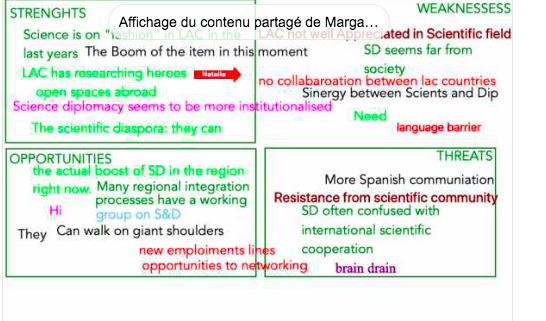
After the breakout session, the attendees reconvened and the chair of each session presented some insights from their group:
Africa
The group discussed whether Africa as a region makes sense to address in the context of science diplomacy: attendees felt like a sub-regional approach might be more relevant considering the diversity of the African continent. The main impression of the science diplomacy landscape in Africa is one of engagement at the regional continental level but not so much in terms of tangible measures – South Africa, Egypt and Tunisia are countries that particularly stand out.
Asia
Here as well some countries like Japan were mentioned in the discussion as more involved with science diplomacy: the programme by the Japanese society for the promotion of science, young scientists’ exchange, science advisors for the Ministry of Foreign Affairs are all examples of Japan’s involvement with science diplomacy. The group also discussed the role of China in Asia as key to the possible development of science diplomacy. It was also reported that the group especially recognized some newly involved countries such as Malaysia.
Middle-East
An example of science diplomacy in that region is undeniably the Sesame programme. Some initiatives from the Emirates were also highlighted such as the ‘education village’. It was also put forward that nationalism/religious intolerance in that region has been detrimental to science diplomacy ties.
Latin America
In that group, it was acknowledged that science diplomacy has become a bit trendy which as both positive and negative consequences, such as the risk to overstretch the concept.
In Latin America, challenges of heterogeneity, multiplicity and lack of integration have been identified. The groups regrets that bilateral ties are prioritized before regional cooperation.
The group also recognized the need for more training in Spanish and the need for science diplomacy to become more institutionalised.
United Kingdom, Canada and USA, Australia and New Zealand
The group addressed the consequences of the Brexit on the UK science diplomacy approach as well as the science diplomacy advancements in Canada as well as the uncertainty, but optimism, with regard to the future of the US commitment to science diplomacy.
In term of institutionalisation, dedicated science and innovation networks have been highlighted in the discussions, e.g. from the UK or Canada – where Quebec is particularly active with its chief scientist and science diplomacy presence. In the US large foundation play a significant role as agents of science diplomacy.
The webinar closed with a few questions to the audience via the Mentimeter tool. To the questions ‘If you met a genie in a bottle and you had one wish to improve SD approaches, what would it be ?’ many different answers were received, for example:
“ to put more focus on bottom-up approaches in constructing science diplomacy practices, to give more weight to the inputs from epistemic communities, scholars and networks”.
“ A cohesive approach involving scientists, diplomats and other key actors”
“Desire to benefit people and the environment over unethical capitalism”
A word cloud was created with answers from the audience to the following question:
Supporting references
As the course is outlined as a complementary interactive activity for the online course, we recommend attendees to be familiar with the topic of discussion by taking the course module
- Müller A, Schmitz S, Josten M (2020). “Which thematic and regional approaches of science diplomacy exist?” S4D4C European Science Diplomacy Online Course, Module 5: S4D4C.
We also recommend reading the additional references below:
Elorza Moreno, Ana/Melchor, Lorenzo/Orts-Gil, Guillermo/Gracia, Cristina/Lacunza, Izaskun/Izquierdo, S4D4C EUROPEAN SCIENCE DIPLOMACY Borja/Fernández-Vera, José Ignacio (2017): Spanish Science Diplomacy: A Global and Collaborative Bottom-Up Approach. In: Science & Diplomacy 6(1) (link)
Flink, T. and Schreiterer, U. (2010). Science Diplomacy at the Intersection of S&T Policies and Foreign Affairs: Toward a Typology of National Approaches. Science and Public Policy, 37(9), pp. 665–677. DOI: (link)
Krasnyak, Olga (2018). National Styles in Science, Diplomacy, and Science Diplomacy. A Case Study of the United Nations Security Council P5 Countries. Leiden/Boston: Brill. (link)
Ruffini, Pierre-Bruno (2017). Science and Diplomacy. A New Dimension of International Relations. Science, Technology and Innovation Studies. Cham: Springer International Publishing (link)
Van Langenhoven, Luk (2016).Tools for an EU science diplomacy. Brussels: European Commission. ISBN 978-92-79 6533

